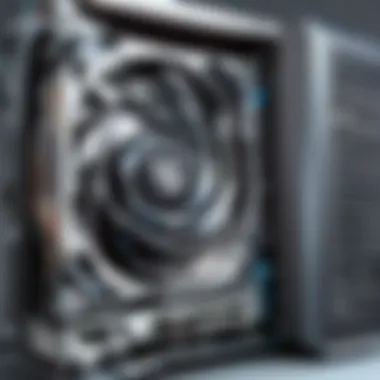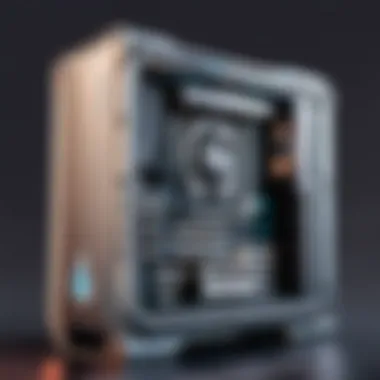Unlocking Gaming PC Performance: Essential Specs Revealed


Game Overview
When embarking on the quest to build a top-notch gaming PC, understanding the foundational components is paramount to achieving a seamless and immersive gaming experience. From the intricacies of processors to the prowess of graphics cards, each facet contributes uniquely to the overall performance of your rig.
Introduction to Building a Gaming PC
Embarking on the journey of constructing a gaming PC opens a realm of opportunities to customize and optimize your gaming experience. The central processing unit (CPU), graphics processing unit (GPU), motherboard, RAM, storage, and power supply unit (PSU) are the cornerstones that warrant meticulous selection and compatibility to ensure optimal performance.
Importance of Key Specs
Delving into the specifics of each component sheds light on their functionalities and how they collectively enrich your gaming escapades. Selecting high-end components enhances frame rates, reduces lag, and elevates graphics quality, culminating in a visually striking and smooth gameplay experience.
Sourcing Components
Procuring components from reputable manufacturers guarantees the longevity and efficiency of your gaming rig. Researching benchmarks, reviews, and compatibility requirements equips you with the knowledge to make informed decisions and construct a PC tailored to meet your unique gaming preferences and demands.
Understanding Essential Gaming PC Specifications
Building a high-performance gaming PC starts with understanding the essential specifications that dictate its capabilities. The choice of components, from processors to graphics cards, determines the overall gaming experience. Each aspect plays a crucial role in optimizing performance and ensuring a smooth gameplay session. Whether you are a casual gamer seeking decent performance or a competitive player aiming for flawless execution, a deep understanding of these key specifications is paramount.
Processor (CPU)
Core Count
Core count stands as a fundamental aspect of a CPU, determining how many tasks it can handle simultaneously. A higher core count translates to better multitasking capabilities and enhanced performance, especially in tasks that benefit from parallel processing like gaming. Gamers looking to run extensive applications alongside their games will find a high core count CPU advantageous. However, for basic gaming needs, a moderate core count may suffice, balancing performance and cost effectively.
Clock Speed
Clock speed, measured in gigahertz (GHz), reflects how many instructions a CPU can execute per second. A higher clock speed signifies faster processing capabilities, resulting in smoother gameplay and quicker load times. Gamers prioritizing seamless performance and swift response times may opt for CPUs with higher clock speeds. Nevertheless, considering the harmony of clock speed with other components is vital for an optimal gaming experience.
Compatibility with Motherboard
Ensuring compatibility between a CPU and motherboard is critical for system stability and functionality. Different CPUs require specific sockets and chipset support on motherboards. Selecting a CPU that harmonizes with your motherboard guarantees a seamless integration, allowing you to unleash the full potential of your PC. Prioritizing compatibility ensures a hassle-free building process with maximum performance output.


Graphics Card (GPU)
GPU Architecture
The architecture of a GPU defines its performance capabilities and efficiency in handling complex graphics tasks. Modern GPUs offer diverse architecture options catering to different gaming needs. Selecting a GPU with a robust architecture ensures high frame rates, smooth rendering, and enhanced visual details, elevating the overall gaming experience. A well-suited GPU architecture can significantly impact gaming performance and graphical fidelity.
VRAM Capacity
VRAM, or Video Random Access Memory, serves as dedicated memory for the GPU to store textures and graphical data. High VRAM capacity enables the GPU to handle large textures and resolutions efficiently, resulting in improved visuals and smoother gameplay experiences. Gamers engaging in modern titles with high graphical demands benefit from GPUs with ample VRAM, ensuring optimal performance and visual quality.
Compatibility with Monitor
Ensuring compatibility between your GPU and monitor is essential for maximizing display output. Different monitors have varying refresh rates, resolutions, and connector types that need to align with the capabilities of the GPU. Selecting a GPU that complements your monitor choice guarantees seamless output, smooth frame rates, and minimal input lag. Gamers aiming for immersive and fluid visuals need to consider GPU-monitor compatibility for an optimal gaming setup.
Random Access Memory (RAM)
Capacity
The capacity of RAM determines how much data a system can store temporarily for quick access. Higher RAM capacity allows for smoother multitasking, faster loading times, and efficient data handling during gameplay. Gamers running demanding applications or multitasking heavily benefit from ample RAM, ensuring a responsive and lag-free gaming experience.
Speed
RAM speed, measured in megahertz (MHz), dictates how quickly data can be accessed and transferred within the system. Faster RAM speeds lead to reduced latency and enhanced system responsiveness, crucial for high-performance gaming setups. Gamers striving for swift data processing and seamless gameplay may opt for RAM modules with higher speeds, elevating overall system performance.
Dual vs. Single Channel Configuration
Choosing between dual and single channel RAM configuration impacts memory bandwidth and system performance. Dual-channel configurations offer improved data transfer rates compared to single-channel setups, enhancing system responsiveness and multitasking capabilities. Gamers seeking optimal performance and smooth data throughput may prefer dual-channel configurations for an enhanced gaming experience.
Storage - Solid State Drive (SSD) and Hard Disk Drive (HDD)
SSD vs. HDD
The choice between SSDs and HDDs revolves around speed and storage capacity trade-offs. SSDs offer rapid data access speeds, reducing load times and system boot times significantly. On the other hand, HDDs provide larger storage capacities at lower costs. Gamers prioritizing speed and quick data access may lean towards SSDs, while those needing expansive storage options might opt for HDDs, striking a balance between performance and capacity.


Storage Capacity
Storage capacity determines the amount of data your system can store, including games, applications, and files. Choosing an appropriate storage capacity depends on your usage requirements and budget constraints. Gamers with vast game libraries and large file sizes will benefit from higher storage capacities, ensuring adequate space for their content without compromising system performance.
Speed and Load Times
The speed of storage drives directly impacts game load times, system responsiveness, and overall performance. Faster storage drives, such as SSDs, deliver quicker data access speeds, reducing load times and enhancing gaming experiences. Gamers seeking swift system boot times and seamless gameplay should prioritize storage drives with high speeds, optimizing their gaming setup for efficient performance.
Optimizing Performance and Future-Proofing Your Build
In the realm of crafting a high-performance gaming PC, optimizing performance and future-proofing the build stands out as a critical juncture. This section delves into strategies that go beyond mere hardware selection to elevate the gaming experience to new heights. By optimizing performance, gamers can unlock the full potential of their components, pushing boundaries and achieving greater gaming fluidity. Future-proofing, on the other hand, ensures that the build remains relevant and competitive in the rapidly evolving landscape of gaming technology.
Overclocking Potential
CPU and GPU Overclocking
CPU and GPU overclocking steers the course towards enhanced performance, allowing users to push their processors and graphics cards to attain higher speeds and capabilities. This method provides gamers with a means to extract additional power from their existing hardware, enabling smoother gameplay and increased FPS rates. The essence of CPU and GPU overclocking lies in the ability to harness untapped potential, tailoring the performance of each component to meet the demands of modern gaming titles. Despite the advantages offered by overclocking, users must tread carefully to avoid overheating and stability issues that can arise from pushing the hardware beyond its limits.
Stability and Heat Management
Stability and heat management play a pivotal role in ensuring that the overclocked components operate efficiently and reliably. By focusing on stability, gamers mitigate the risks associated with system crashes and performance inconsistencies, fostering a seamless gaming experience. Effective heat management, on the other hand, involves employing robust cooling solutions to dissipate excess heat generated during overclocking. These measures are imperative in safeguarding the hardware from long-term damage and maintaining optimal performance levels.
Upgradability and Component Compatibility
Future Component Upgrades
The concept of future component upgrades underscores the dynamic nature of PC gaming, where users constantly seek to enhance their systems with newer and more powerful hardware. By considering future component upgrades during the initial build phase, gamers pave the way for seamless integrations and expansions, ensuring that their rig remains adaptable to emerging technologies. This forward-thinking approach grants users the flexibility to evolve their setups according to their changing needs and aspirations.
Compatibility Checks
Compatibility checks serve as the cornerstone of a successful upgrade path, preventing compatibility issues that could impede the integration of new components. By meticulously assessing compatibility factors such as form factors, socket types, and power requirements, users safeguard against potential bottlenecks and performance limitations. Conducting thorough compatibility checks guarantees a smooth transition from older to newer hardware, promoting a harmonious system configuration.
Budget Considerations and Value for Money


Cost-Performance Ratio
The cost-performance ratio embodies the essence of maximizing the value derived from every dollar invested in the gaming rig. This metric assesses the balance between the cost of components and the performance gains they deliver, guiding users towards cost-effective yet high-performing choices. By prioritizing components with favorable cost-performance ratios, gamers can achieve optimal performance without breaking the bank, striking a harmonious equilibrium between budget constraints and gaming ambitions.
Balancing Performance and Budget
Balancing performance and budget marks a delicate art of allocating resources to maximize gaming performance within defined financial boundaries. This strategic approach involves identifying key performance areas that align with personal gaming preferences while respecting budget limitations. By discerning where to splurge and where to save, users can construct a gaming setup that offers a stellar gaming experience without compromising on financial prudence.
Assembling Your Gaming PC and Software Optimization
In this comprehensive guide to building a gaming PC, one of the pivotal steps is the assembly process and software optimization. Without meticulous attention to detail during the assembly phase, even the most powerful components may not function optimally. Proper assembly not only ensures the smooth operation of the system but also plays a crucial role in maximizing performance and longevity.
Building Process:
Component Installation
Component installation is a critical aspect of building a gaming PC that demands precision and expertise. The way components such as the processor, graphics card, RAM, and storage drives are installed can impact the system's overall efficiency and stability. Proper installation ensures that each component functions seamlessly with the rest of the system, contributing to a smooth gaming experience. It is essential to follow manufacturer guidelines and best practices to guarantee accurate installation and prevent any potential hardware issues.
Cable Management
Efficient cable management is often overlooked but is vital for maintaining proper airflow and ensuring a clutter-free interior. Well-organized cables not only improve the aesthetic appeal of the PC but also contribute to better airflow, which is crucial for cooling components effectively. Proper cable management reduces the risk of overheating and improves the overall efficiency and longevity of the system.
Thermal Paste Application
Applying thermal paste correctly is crucial for the cooling performance of the processor. Thermal paste helps facilitate the transfer of heat from the processor to the heat sink, ensuring efficient cooling. A thin and even layer of thermal paste is recommended to optimize heat dissipation. Proper application of thermal paste helps prevent overheating and ensures the processor operates within safe temperature limits, ultimately enhancing the system's overall performance and stability.
Driver Installation and System Tweaks:
Graphics Drivers
Graphics drivers play a vital role in optimizing the performance of the graphics card and ensuring smooth gameplay. Keeping graphics drivers updated allows the GPU to function at its full potential, providing better graphics quality and enhanced frame rates. Properly configured graphics drivers can also resolve compatibility issues and enhance system stability, leading to a better gaming experience overall.
BIOS Updates
Regular BIOS updates are necessary to improve system compatibility, enhance stability, and add new features. Updating the BIOS ensures that the motherboard operates efficiently with the latest hardware and software components. Additionally, BIOS updates can address security vulnerabilities and fix bugs that may affect system performance. However, it is essential to follow manufacturer instructions carefully when updating the BIOS to prevent any potential risks or complications.
Performance Monitoring Tools
Utilizing performance monitoring tools allows users to track system metrics in real-time, such as temperatures, fan speeds, and utilization rates. These tools provide valuable insights into the system's performance and help identify any potential issues or bottlenecks. By monitoring key metrics, users can make informed decisions to optimize system settings, troubleshoot problems, and maintain peak performance levels for an optimal gaming experience.



